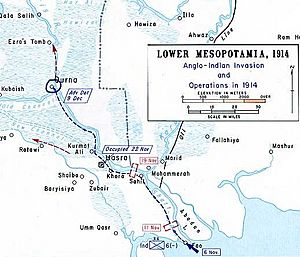Battle of Qurna facts for kids
Quick facts for kids Battle of Qurna |
|||||||||
|---|---|---|---|---|---|---|---|---|---|
| Part of the Mesopotamian Campaign of World War I | |||||||||
 This map shows the initial British attack and capture of Basra, 1914. |
|||||||||
|
|||||||||
| Belligerents | |||||||||
| Commanders and leaders | |||||||||
| Strength | |||||||||
| 2,100 | 1,000 | ||||||||
| Casualties and losses | |||||||||
| 281 | 1,000 | ||||||||
| Approximate figures | |||||||||
The Battle of Qurna happened from December 3 to 9, 1914. It was a fight between British soldiers and Ottoman soldiers. The Ottomans had just lost the city of Basra in an earlier battle during World War I in a place called Mesopotamia.
Contents
Why the Battle Happened
The British had just captured Basra. This was a very important city for communication and industry. The Ottoman soldiers retreated up the Tigris River. The British needed to make sure Basra was safe. They also wanted to protect the oil fields in Abadan.
After losing Basra, the Ottomans decided to set up their defenses in a small town called Qurna. Qurna was a great spot for defense. This is because both the Tigris and Euphrates rivers meet there. This meant the British would have to cross two rivers to reach them.
The Ottomans had about 1,000 soldiers. Their leader was Colonel Subhi Bey, who was also the governor of Basra. The British had about 2,100 soldiers. Their commander was Major General Charles Irwin Fry.
The Battle Begins
On December 3, the Ottoman soldiers were ready in Qurna. A British force attacked them. This force included two Indian army groups, the 104th Wellesley's Rifles and the 110th Mahratta Light Infantry. There was also a group of British soldiers from the Norfolk Regiment. Several British gunboats helped by firing at the Ottomans.
The Royal Navy gunboats on the Euphrates River kept firing. This allowed British troops to cross the Tigris River. The British and Indian soldiers moved forward across open land. But they could not cross into Qurna itself. So, the British force had to pull back.
Second Attack
On December 6, the British tried again. They had more soldiers now. The rest of the Norfolk Regiment joined them. Also, the 7th Rajputs and 120th Infantry arrived. They also had some mountain guns.
The Ottomans had moved back into positions they had lost earlier. So, the British and Indian troops had to capture those spots again. They pushed the Ottomans back once more. But they still could not cross the river into Qurna.
Final Push and Surrender
On December 8, two Indian groups, the 104th and 110th Infantry, went up the Tigris River. They found a place to cross. By doing this, they stopped the Ottomans from escaping to the north. At the same time, the gunboats kept firing on the Ottoman positions in the town.
On the night of December 8, an Ottoman ship sailed down the river. It had its lights and sirens on. Lieutenant Commander Wilfrid Nunn of the British gunboat Espiegle met with three Ottoman officers. The Ottomans wanted to give up the town and march away. Nunn, who was not in touch with his commander Fry, said they had to surrender completely. This made the Ottomans unhappy. However, they finally agreed.
On December 9, the Ottoman commander, Colonel Subhi Bey, surrendered his forces. About 42 Ottoman officers and 989 soldiers were captured. The British and Indian forces had 27 soldiers killed and 242 wounded. Two British sailors were killed and 10 were wounded.
What Happened Next
The Battle of Qurna was more like a small fight than a huge battle. But it was important for the British. It gave them a safe front line in Southern Mesopotamia. Basra was now secure. The oil refineries at Abadan in Persia were also safe.
However, the Ottomans would try to fight again later at Shaiba. The British would also launch another attack to try and capture Baghdad.
Images for kids
See also


